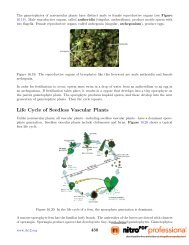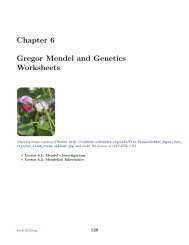Chapter 23 The Circulatory, Respiratory, Digestive, and Excretory ...
Chapter 23 The Circulatory, Respiratory, Digestive, and Excretory ...
Chapter 23 The Circulatory, Respiratory, Digestive, and Excretory ...
You also want an ePaper? Increase the reach of your titles
YUMPU automatically turns print PDFs into web optimized ePapers that Google loves.
Table <strong>23</strong>.3: (continued)<br />
Vitamin Function Good Food Sources<br />
C making connective tissue oranges, red peppers<br />
D healthy bones <strong>and</strong> teeth salmon, eggs<br />
E normal cell membranes vegetable oils, nuts<br />
K blood clotting spinach, soybeans<br />
Minerals are chemical elements that are essential for body processes. <strong>The</strong>y include calcium, which helps<br />
form strong bones <strong>and</strong> teeth, <strong>and</strong> potassium, which is needed for normal nerve <strong>and</strong> muscle function. Good<br />
sources of minerals include green leafy vegetables, whole grains, milk, <strong>and</strong> meats. Vitamins <strong>and</strong> minerals<br />
do not provide energy, but they are still essential for good health. <strong>The</strong> needed amounts generally can be<br />
met with balanced eating. However, people who do not eat enough of the right foods may need vitamin<br />
or mineral supplements.<br />
Balanced Eating<br />
Balanced eating is a way of eating that promotes good health. It means eating the right balance of different<br />
foods to provide the body with all the nutrients it needs. Fortunately, you don’t need to measure <strong>and</strong><br />
record the amounts of different nutrients you each day in order to balance your eating. Instead, you can<br />
use MyPlate <strong>and</strong> food labels.<br />
MyPyramid <strong>and</strong> MyPlate<br />
MyPyramid shows the relative amounts of foods in different food groups you should eat each day (see<br />
Figure <strong>23</strong>.28). You can visit the MyPyramid Web site (http://www.mypyramid.gov) to learn more about<br />
MyPyramid <strong>and</strong> customize it for your own gender, age, <strong>and</strong> activity level.<br />
Each food group represented by a colored b<strong>and</strong> in MyPyramid is a good source of nutrients. <strong>The</strong> key in<br />
Figure <strong>23</strong>.28 shows the food group each b<strong>and</strong> represents. <strong>The</strong> wider the b<strong>and</strong>, the more you should eat<br />
from that food group. <strong>The</strong> white tip of MyPyramid represents foods that should be eaten only once in<br />
awhile, such as ice cream <strong>and</strong> potato chips. <strong>The</strong>y contain few nutrients <strong>and</strong> may contribute excess Calories<br />
to the diet. <strong>The</strong> figure “walking” up the side of MyPyramid represents the role of physical activity in<br />
balanced eating. Regular exercise helps you burn any extra energy that you consume in foods <strong>and</strong> provides<br />
many other health benefits. You should be active for about an hour a day most days of the week. <strong>The</strong><br />
more active you are, the more energy you will use.<br />
In June 2011, the United States Department of Agriculture replaced My Pyramid with MyPlate. MyPlate<br />
depicts the relative daily portions of various food groups. See http://www.choosemyplate.gov/ for further<br />
information.<br />
<strong>The</strong> following guidelines accompany MyPlate:<br />
1. Balancing Calories<br />
• Enjoy your food, but eat less.<br />
• Avoid oversized portions.<br />
2. Foods to Increase<br />
• Make half your plate fruits <strong>and</strong> vegetables.<br />
715 www.ck12.org





